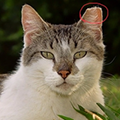
|
|
Animal Shelter
Shelter Manager Valerie Robinson

Community Cats
What is Trap-Neuter-Return (TNR)?Community cats can provide a free and natural form of pest control for neighborhoods. A high-intake animal shelter, such as TPAS, simply does not have the capacity to find adopters for the thousands of cats who are found living outdoors. Many cats who live outside also have not been socialized to live indoors with humans and are better suited to life outdoors. If you find a community cat without a tipped ear, the best thing to do is Trap-Neuter-Return (TNR). TNR is the process of humanely trapping and transporting community cats for spay/neuter surgery, rabies vacation, and ear-tipping. After the procedures, the cat is returned to their outdoor home. All cats that are outdoors, even for just a short period of time, need to be spayed/neutered and vaccinated. How Does it Work?
What are the Benefits of Spayed/Neutered Community Cats?
What Do I Do if I See a Cat in My Neighborhood?It takes a Community! Shelters and animal welfare groups across the country are implementing community cat programs to great success with the help of their community. TPAS has joined that effort in humanely and effectively addressing the cat population in our community. If you see a cat with an ear-tip, it has already been trapped, neutered, and returned. It doesn't need to be helped and should be left alone. If you see a cat without an ear-tip, follow these steps:
What if I Don't Want Cats in My Neighborhood?Community cats already exist in our community. The Trap-Neuter-Return (TNR) is the only effective humane way to reduce the population. Our community tried the trap-and-eliminate method for decades without success, as this often creates a “vacuum effect,” encouraging more cats to come into a neighborhood or community. It also helps save lives, as one of the most vulnerable populations in the shelter are young kittens. When community cats are spayed/neutered, unwanted or unexpected litters will reduce around the region. Tips for Living with Community Cats
For more tips, check out Alley Cats Allies. Additional Resources
For more information, please call (985) 873-6709. |
NewsJob OpportunitiesContact
Hours of Operation
Physical Address
Mailing Address
|
Resources
|
|
Connect
|
|
©2024 Terrebonne Parish Consolidated Government
0 |
